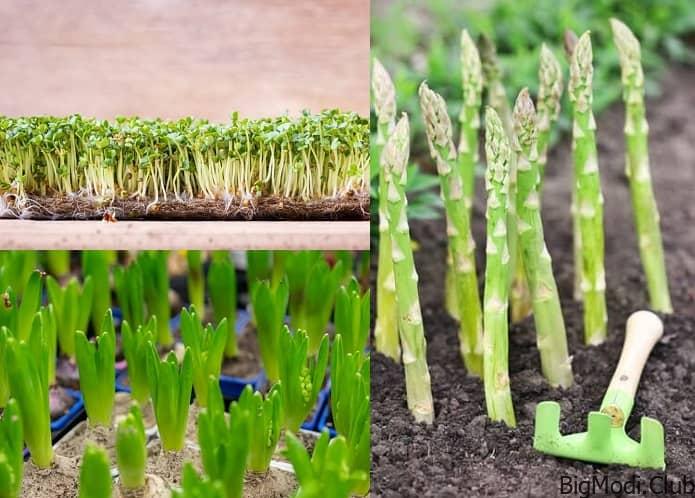Growing asparagus is a rewarding process that, when done right, can provide delicious harvests for years. In this guide on How to Grow Asparagus, we’ll explore the steps needed to cultivate this resilient and perennial vegetable, from choosing the right environment to post-harvest care. Whether you’re planting from crowns or seeds, it’s important to understand the patience required, as asparagus takes a few years before it’s ready for a full harvest. With proper care, however, you’ll soon be enjoying fresh asparagus straight from your garden. Let’s dive into How to Grow Asparagus and uncover the secrets to successful cultivation.
How to Grow Asparagus
Growing asparagus requires a bit of patience, but the long-term rewards make it well worth the effort. This perennial vegetable thrives with the right conditions and care, offering bountiful harvests year after year. In this guide, we’ll explore everything from selecting the ideal growing environment to harvesting and maintaining your asparagus plants for lasting success.
Finding the Right Environment
To grow healthy asparagus, it’s essential to choose a sheltered spot with well-draining soil. While full sun is ideal for maximum growth, asparagus can also tolerate some dappled shade. The pH level of the soil should be between 6.5 and 7.5 for optimal growth. Before planting, make sure the ground is completely free of weeds—this crop doesn’t like competition!
Deciding How to Plant: Crowns or Seeds?
Asparagus can be grown from either one-year-old crowns (dormant plants) or seeds. Crowns are the faster route, allowing you to harvest spears after just two years. Seeds, on the other hand, take longer, with harvesting beginning in the third year, but they are more economical if you’re looking to plant a large crop.
Planting Asparagus crowns
When planting Asparagus crowns, dig a trench that’s 30 cm (1 foot) wide and 20 cm (8 inches) deep. Add some well-rotted manure or compost to the base, then create a small ridge of soil down the center of the trench. Place the crowns carefully on the ridge with their growing points facing upward. Make sure to space the crowns 30-45 cm (12-18 inches) apart, and leave about 45 cm (18 inches) between rows. Cover the crowns with soil, but leave the buds visible. This spacing ensures that each plant has enough room to thrive and develop fully.
Caring for Your Asparagus
Once planted, asparagus plants need regular weeding, especially during their first growing season. Make sure to water them consistently throughout the summer. After the first year, these plants become fairly drought-resistant, only needing water during prolonged dry periods. To keep moisture in the soil and prevent weeds, apply mulch around the plants. Mulching also improves soil fertility, which asparagus appreciates.
When to Harvest Asparagus
Patience is key when growing asparagus. You’ll need to wait 2-3 years before your first harvest. Once ready, cut the spears when they reach a height of around 18 cm (7 inches) or about the thickness of a finger. During the third year, you can harvest for six weeks, and in following years, for eight weeks. On average, each plant will yield around 10 spears during the harvest period.
Post-Harvest Care (how to care for asparagus)
After the harvesting season, it’s important to let the remaining shoots grow into tall, feathery plants. These “ferny” growths gather energy to support next year’s harvest. In autumn, once the foliage turns yellow, cut the plants down to the ground. Come spring, they will resprout and the cycle begins again.
Propagation and Long-Term Maintenance
To propagate asparagus, you can divide well-established crowns every three years. The best time to do this is in late winter or early spring. Carefully dig up the crowns and separate them into smaller sections, each with several growing points. Replant them immediately in fresh soil, following the same guidelines for crown planting.
How to Propagate Asparagus Fern
Propagating an asparagus fern can be an easy and rewarding process. Here’s how you can do it using two effective methods:
1. Berry Propagation
If your asparagus fern produces berries, you can use them to grow new plants. Although this method is less common, it is still an effective way to propagate. Simply plant the berries in soil, and with some patience, they will eventually sprout. While this approach may take longer and isn’t always reliable, it’s a great option if you notice berries on your plant.
2. Division Method
The most common and straightforward way to propagate an asparagus fern is through division. This method works best in spring, particularly when repotting the plant. Gently remove the plant from its pot and carefully divide the rootball into two or more sections, ensuring each section has roots attached. Once divided, plant each section into its own pot, allowing them to grow into new plants.
FAQs
How long does it take to grow asparagus?
It typically takes 2-3 years for asparagus to be ready for its first harvest. If grown from crowns, you can expect to start harvesting after two years, while seeds take about three years.
Are asparagus hard to grow?
Asparagus isn’t difficult to grow but does require patience and some initial effort. Once established, it’s a low-maintenance crop that will produce for up to 20 years with proper care.
How many asparagus do you get from one plant?
On average, each asparagus plant produces around 10 spears per year once fully established, though this number can vary depending on growing conditions and plant health.
Where is the best place to grow asparagus?
Asparagus grows best in a sunny, sheltered spot with well-draining soil. A pH level of 6.5-7.5 is ideal, and the area should be weed-free to reduce competition for nutrients.


